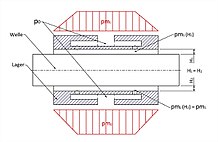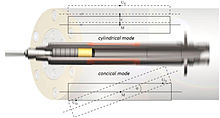Air bearing spindle
An air bearing spindle is a direct drive shaft with a tool interface that is supported by an air bearing. These spindles are primarily used as the main spindle in precision machine tools , in micro- machining and in the circuit board drilling industry. Thanks to the contactless mounting, very high speeds can be achieved, which is particularly important in micro-machining due to the small tool size and the associated high cutting speed .
Air bearings
In the bearing gaps, which are only a few micrometers thick, dynamic processes such as squeeze film dampers , shear flows ( dynamic lift ) and aerodynamic effects play the dominant role and generate gap flow velocities (without any movement of the bearing pairs) of more than 250 m / s.
A distinction is made between aerodynamic and aerostatic bearings, the bearing pressure in the former being generated only by the relative movement of the bearing pairs themselves, which for this purpose have special features such as elevations and / or structures. As a striking example, the figure shows a sectional view of a static and aerodynamic radial bearing without a shaft. With aerostatic bearings, the bearing pressure must be applied from the outside into the bearing gap. For static air bearings, the bearing gap is therefore abstractly the gap system between the outlet and inlet and is dependent on these in many respects and above all dynamically.
The bearing function is based on the axial and tangential pressure distribution, which generates the load-bearing capacity, as well as the air flow through the bearing gap, which is mainly responsible for generating rigidity . Here, rigidity corresponds to the change in load capacity with the radial displacement of the shaft (radial bearing) or the axial displacement of the plate (axial bearing). The pressure distribution and the flow, however, are functions of the bearing gap and the throttling, a distinction being made here between throttling at the inlet (inlet throttled) or at the outlet (outlet throttled).
Advantages of air bearing spindles
Radial air bearings can achieve the same rigidity and even better damping values than roller bearings if they are correctly designed. The air gap of an air bearing, which is only a few micrometers in size, has a compensating effect for shape and size errors in the shaft or the bearing due to the properties of the air, which allows a resulting accuracy that is better than that of the individual components. Air bearing spindles have an asynchronous accuracy that is around a factor of ten better than that of roller bearing spindles and a synchronous accuracy that is around a factor of two better. This means that the rigidity and damping of air bearings can definitely compete with those of roller bearings, but offer radial error movements of sometimes less than 12 nm and axial movements of less than 10 nm, even at speeds of over 50,000 / min and relative speeds of up to 250 m / s. At low sliding speeds , air bearings are also extremely low-friction and lubricant-free, which explains their use in navigation systems and in the food industry , for example .
- smaller synchronous and significantly smaller asynchronous errors axially and radially
- The balancing effect of the medium (air, for example) between the bearing and the moving shaft produces rotational movements that are more precise than the accuracy of the sum of the individual parts. Air bearing spindles therefore have asynchronous and synchronous errors that are several factors better than roller bearings, which hard transfer errors from bearing tracks and all balls. Asynchronous errors of less than 10 nm are possible with slowly rotating spindle systems without any hurdles
- higher speeds
- In addition to minor synchronous and asynchronous errors, the most characteristic feature of air bearing spindles is the significantly higher speed limits compared to the shaft diameter of roller bearing spindles. Shear speeds of 200 m / s in radial bearings and 450 m / s in axial bearings can be achieved without any problems.
- Maximum speed without time limit - reliable stationary operation
- Rolling bearing spindles cannot be operated continuously at their nominal speed and respond with the bearings getting hot, increasing running noise and ultimately failure. Air bearing spindles are the perfect answer for the increasingly common applications with machining times of hours to weeks at the highest speeds, with strictly constant operating conditions and practically no time limit for continuous operation at nominal speed.
- extremely short ramp times
- While the acceleration and braking ramp times of roller bearing spindles are limited by the bearing cage, only the maximum current of the motor limits the acceleration and braking values in well-designed dynamic air bearing spindles.
- no prelubrication time - immediate operation
- While roller bearing spindles require a prelubrication time of sometimes minutes before their operation and sometimes after a certain period of operation, an air bearing spindle with activation of the bearing air, cooler and converter is immediately fully operational.
- extremely small axial shaft growth over speed
- If the shaft growth of 50–100 µm in roller bearing spindles requires length compensation via the machine control, a correctly designed air bearing spindle with 1–5 µm allows most applications to dispense with this.
- simple construction and extremely short repair times
- An air bearing spindle can withstand loads similar to that of a roller bearing spindle, but while roller bearing spindles respond to overload with loud bearing noises, higher bearing temperatures and lack of accuracy, the shafts of air bearing spindles usually block.
- Oil, grease and contactless operation
- No grease, no oil, no wear and tear. If handled properly, this makes the air bearing spindle in principle maintenance-free and allows it to be used in a gas-containing and / or clean room-like environment or, for example, in the food industry. Here the surrounding gas - z. B. CO 2 - can also be used as a storage medium.
- no anti-static measures
- The widespread use of ceramic rolling elements (hybrid rolling bearings) requires anti-static measures such as brushes or rollover mandrels to avoid sparks between the tool and the workpiece in rolling bearing spindles. Due to the immense area between the shaft and the bearing and the gap that is only a few micrometers in size, air bearing spindles conduct these energies via the resulting capacitor via the bearings and thus to the protective conductor and generally make the use of anti-static measures superfluous.
- no axial retention system when changing tools
- Rolling bearings require an extremely complicated catch system which absorbs the axial forces when changing tools so as not to damage the spindle bearings. The axial bearing plate of air bearing spindles, however, is so large that it is simply applied when the tool is changed, with extremely low surface pressures.
throttling
The following example (bearing-induced natural frequency modes) is intended to explain why throttling of the supply pressure in the bearing gap of a static air bearing is so important and decisive for performance. In the stability and resonance analysis shown, the wave between the upper and lower bearing edge is in geometrical and physical equilibrium. There is pressure all around pm = pm1 = pm2 between the rows of nozzles. Due to a disturbance - for example a cutting force - the shaft is now shifted as shown in the illustration and creates gaps H1 and H2 of different sizes.
If the feed pressure P0 were now passed unthrottled into the bearing gap, the same pressure and thus the same force would prevail over the circumference. A restoring force against the "disturbance" would therefore be missing, the bearing would have no function. By means of analytically and iteratively calculated and optimized nozzles - fed by the feed pressure p 0 - an intermediate pressure p m (H, p 0 ...) is generated after the nozzle, which sometimes depends on the bearing gap thickness H immediately after the nozzle. Ergo, the smaller the bearing gap after the respective nozzle, the higher the intermediate pressure p m after the nozzle and thus also the pressure force. Thus, if the shaft is displaced due to a disturbance, a path-dependent restoring force and thus also rigidity - that is, a change in restoring force with displacement - are guaranteed.
Dynamism and stability
A static air bearing has an external pressure supply and generates load capacity, rigidity and damping according to the principle of gap-dependent throttling, whereby the shaft is coupled through the bearing gap and with its polar and transverse moments of inertia and its mass, in abstract terms, a spring-mass damper System represents. Accordingly, there are also position-induced natural frequencies, i.e. if I hit the shaft, it oscillates with the position-dependent system natural frequency, the amplitude in turn being determined by the damping. This also implies that a spindle system with air bearings, for example, is inherently a vibratory system with the modes “cylindrical” and “conical”, whereby the pivot point of the conical mode always goes through the center of mass of the shaft. These natural frequencies, however, depend on the bearing rigidity, which in turn depends both on the bearing gap width or shape and on aerodynamic effects at speed. Thus, a spindle changes its stiffness at speed and thus also the bearing-induced natural frequencies. These natural frequencies must be known for two reasons, on the one hand to avoid rotational frequencies of the spindle in the vicinity of these natural frequencies due to vibrations (excessive elevation), and to be able to carry out a stability analysis.
Half frequency vortex
There is now a very decisive difference to roller bearings, because with air bearings, be it static or dynamic nature, there is a state of half-frequency vortex, which must be avoided at all costs and must therefore be calculated in advance. The half-frequency vortex is an instability of air bearings in which the shaft starts to stir against the direction of rotation at half the rotational frequency. This state occurs, the rotational frequency and thus the rotational frequency excitation with the unbalance reaches twice the currently prevailing first natural system frequency. From a physical point of view, this is the state in which the damping becomes zero and the amplitudes thus infinite.
In addition to the bearing-induced rigid-critical natural frequencies, there is also the bending-critical natural frequency of the shaft itself. Each material has an elasticity module , which, figuratively speaking, corresponds to a spring rate. Thus - comparable to a tuning fork - the shaft is also a vibratory system. If the frequency of the critical natural frequency is reached with the rotational frequency, the shaft begins to oscillate in such a way that air bearings and ball bearing solutions fail here due to the narrow bearing gap and low damping. Fluid bearings, however, have sufficient damping and sufficiently large bearing gaps to pass through this bending-critical natural frequency. An air-bearing shaft is thus operated sufficiently below the conical / cylindrical rigidity critical, but necessarily below the half-frequency critical and the first bending critical. Fluid-mounted spindles or systems can, however, be operated between the first and second bending critical.
literature
- J. Engmann: Electroplated micro grinding points - development, manufacture and use. Dissertation: Technical University of Kaiserslautern, Mechanical and Process Engineering, 2011, ISBN 978-3-941438-59-0
- R. Dupont: Isotropic and centrifugally invariant designed, gas-lubricated spiral groove bearing in conical design for the highest rotational frequencies . Dissertation: Technical University of Kaiserslautern, mechanical engineering and process engineering, 2005








